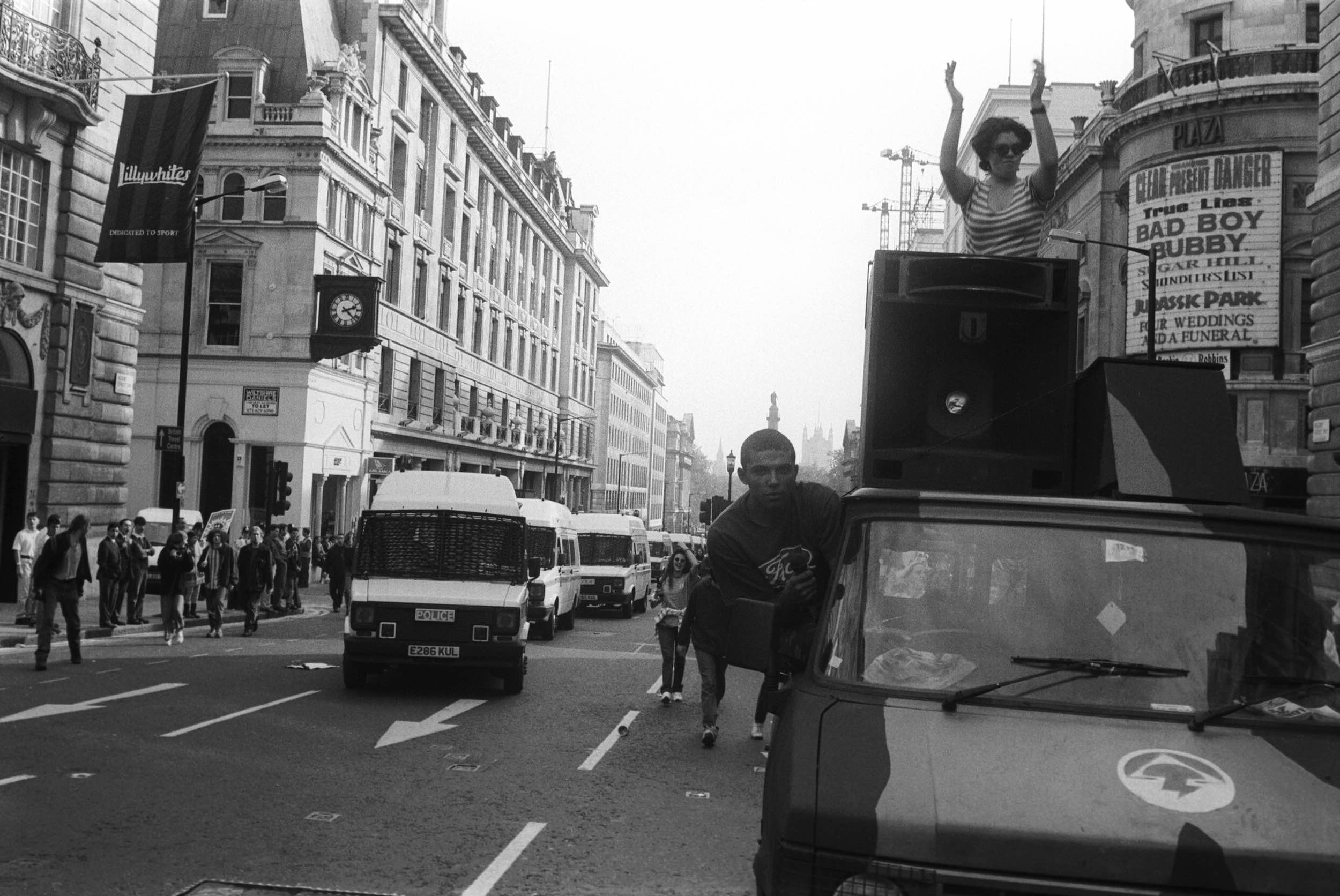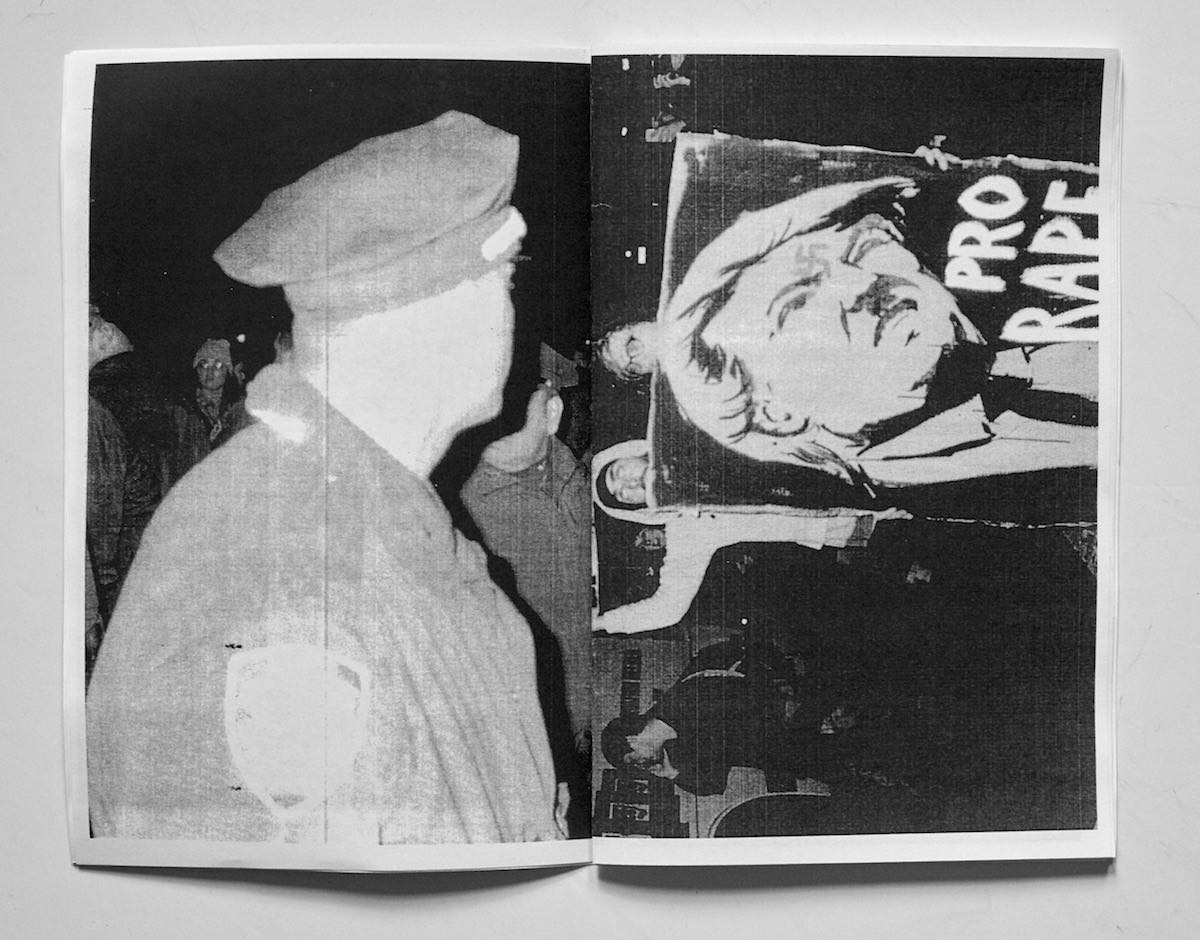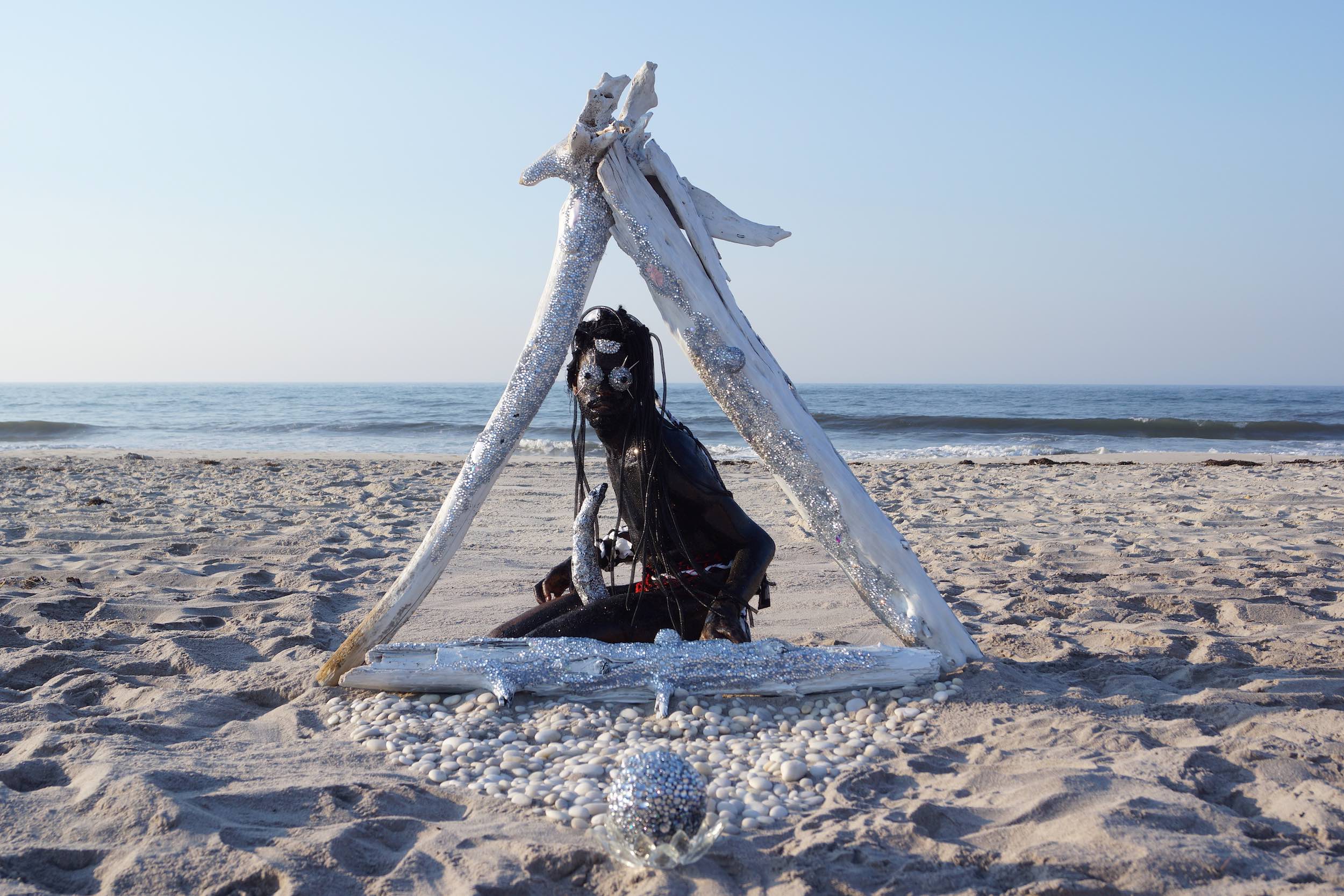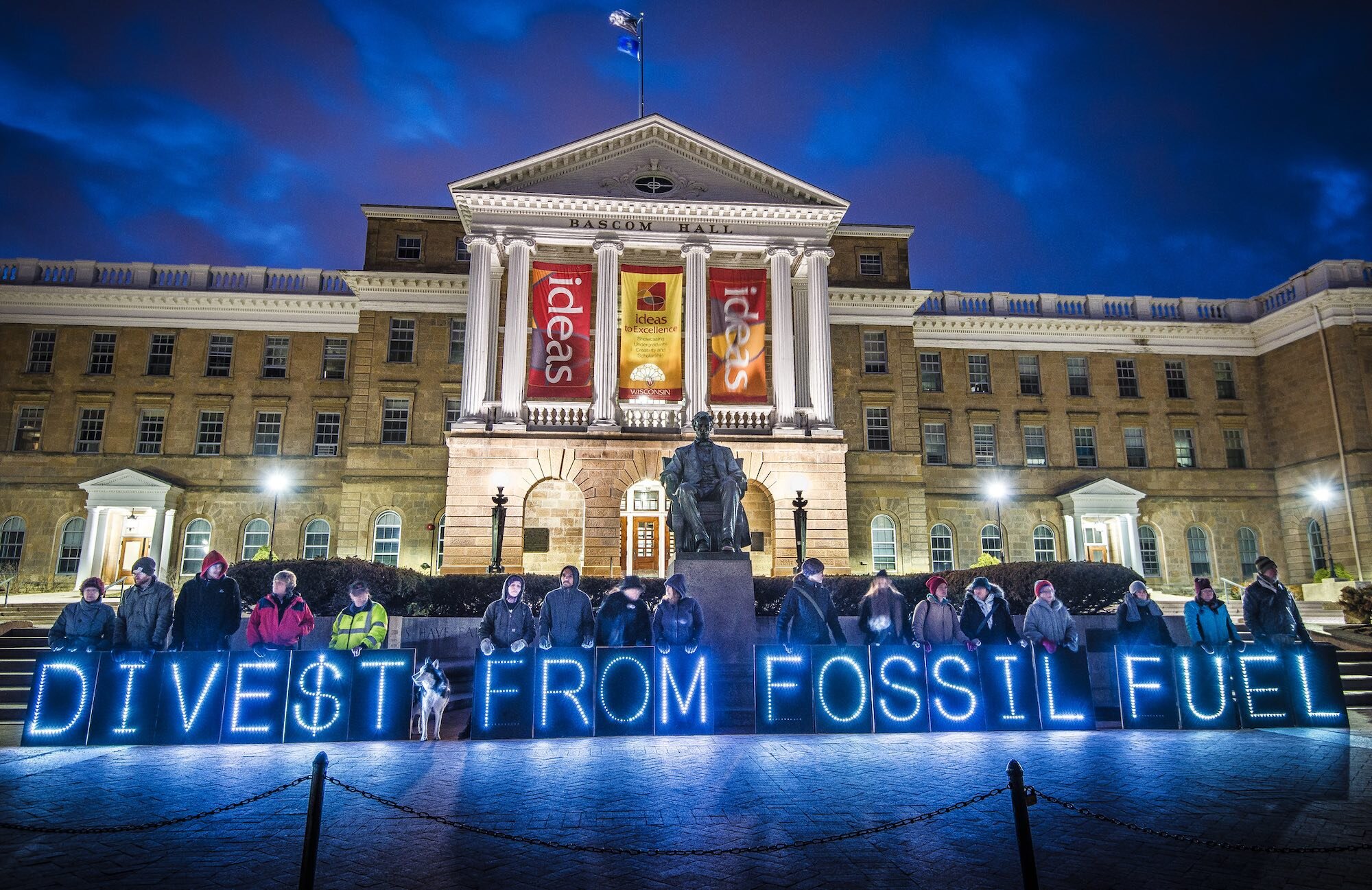Rave & Resist: the British 90s Youth Protest Underground

EXIST TO RESIST is a new book celebrating the British DIY protest and rave culture of the 1990s, featuring photographs by Matthew Smith.
Featuring images taken at parties, festivals and protests between 1989 and 1997, the Kickstarter project aims to show a personal take on the turbulent era when rave, traveller culture and the road protest scene meshed into an uprising of grassroots resistance, pushing back against a decade and a half of conservative government and repressive legislation such as 1994's Criminal Justice Act – including a series of major protests and disturbances in central London during the summer of that year.
This unique history of an often overlooked aspect of British DIY youth culture is a collaboration with non-profit Youth Club – you can find out more and support the project here. Good Trouble spoke to Matt about his life documenting rave and resistance, and his top three protest moments of all time...
GOOD TROUBLE: What was so special about 90s UK youth/protest/party culture?
MATTHEW SMITH: The free festival scene in the UK had grown out of the 60s and 70s and the amount of people choosing to escape the rent/mortage trap by living on the road during the early 80s was rapidly mushrooming in response to housing legislation. This was also a time when government was selling home ownership to the population in a massive way, just in time for mass home repossessions caused by Thatcher's recession at the end of the 80s.
Government had already unleashed the full force of state-sponsored violence against the traveller/festival community at the Beanfield in 1985 when it shut down the 12th successive Stonehenge Free Festival to prevent it from gaining a legal right to existence from then on. That hadn't worked to discourage people from making that lifestyle choice. In fact, it kind of made it more attractive. Then, of course, rave happened and gave the social phenomenon a whole new mass popularity, and more importantly gave people living a mobile lifestyle a means of funding their choice of housing and lifestyle.
So, what linked road protests, raves, political marches, festivals... how did it all come together?
Clearly, there are many reasons. The Criminal Justice and Public Order Act linked all these things together in its criminalisation of rave, free parties and festivals, squatting, trespass and peaceful protest – it even removed the age-old right to silence. That, and the ongoing history of callous treatment of the public meted out by a Conservative government that had been in residence since 1979.
“People found camaraderie, community, fun and an outlet to counter a feeling of oppression in rave culture.”
It was also down to the attempt to introduce the Poll Tax, and again the political violence unleashed against those who took part in the campaign of opposition against that… There was also the very visible mistreatment of the Miners and Print Unions… they suffered the heavy hand of the state in their attempt to stand up for workers rights.
People found camaraderie, community, fun and an outlet to counter a feeling of oppression in rave culture. There is something instinctively fundamentally attractive in feeling some love for your fellow human beings.
Could something like that happen again, do you think?
It would be nice to think so but the mechanisms put in place to prevent such situations have now had a couple of decades to evolve. On another level, digital technology has had an influence and people can now communicate with much more ease from their screens... That convenience seems to have had an effect on people's will and desire to assemble and seek out each other's company in great numbers, especially when doing that is constantly defined as something that is not "safe", whatever that means.
Clown Girl, Harvest Fayre Cilgerran Wales 94
And what lessons do you think that scene might have to teach us today in the current social climate?
DIY culture is a popular piece of media jargon at the moment but at its heart it means 'Do It Yourself'. That means house yourself. Employ yourself. Look after yourself and those around you. Create your own future, work to manifest the equality, liberty and kind of society that you would wish to be a part of.
Wanstonia Eviction NoM11 Link Protest, Feb 94
What do you want to achieve by telling this story at this moment in time?
I want to remind people just how much freedom has been compromised in a very short space of time, by showing work that was made in only the very recent past. I also want to remind people that the work I made was the result of a bunch of ordinary, nice, everyday people getting together to stand up for what they thought was right.
I think it was the Romans who came up with the idea of assimilation during their Empire building. Essentially it was the idea that it caused a lot more trouble to rule people if you didn't allow them to worship their own gods… If God is actually now a DJ, it doesn't take much imagination to see how things are progressing. A quick look at the massive revenue generated by the festival industry for corporate media, event and entertainment owners, the policing and security industries, the Inland Revenue and local government licensing committees will also help to achieve a bit of clarity.
We live in an era of big data now, and access to festival and music culture is almost exclusively through digital communication – whereas in the past it was largely anonymous via physical tickets, or in the case of free parties, simply by attendance. People have to draw their own conclusions from those facts.
Free Festival Ravergirls, Bristol 95
What was the lasting legacy of that time for music, youth culture, politics?
Who can tell? History is still evolving and it will be is what a lot of people help it evolve to be. One thing is for certain though, and that is the amazing festival-going public will wade through waist-high mud and rain, interspersed with the occasional bit of dream weather, to do what it likes best. I can't think of another industry that has a clearer strength of demand for its product , can you? And people are still taking buildings to have parties in, and finding beautiful, out of the way locations in which to throw sound system parties. The desire to go rigside is very much still out there.
I recall Desert Storm turning up and blasting out music at the anti-Criminal Justice Bill march in London in 1994. What are your top three party-protest moments and why?
“On the first of the three anti-CJA marches… Desert Storm were down in the Square with their rig, and we got the signal to turn on. At the first bass notes, the crowd turned round as one and roared. The excitement in feeling that will stay with me for life.”
1) That moment, that first moment, on the first of the three anti-CJA marches, when we were parked up with the rig on the lorry in front of the National Portrait Gallery at the top end of Trafalgar Square. The speakers finished, Desert Storm were down in the Square with their Bedford CF rig, and we got the signal to turn on. At the first bass notes, the crowd turned round as one and roared. That did it for me, totally sober, totally rushing with adrenaline up my spine… the excitement in feeling that response from the huge crowd to the music was just epic and will stay with me for life.
2) Cruising down Park Street one Saturday night in Bristol in early 95, with my friend Patrick in the front seat of his 1950s 16kva fairground generator truck, on the way to the biggest party that Sunnyside ran in a warehouse off Feeder Road in 1995… We got there and found the biggest queue of people waiting to be let in, and once the power had been connected that was just what we did! The following morning at 7am cos it was light, the warehouse was simply pumping with something like 6000 people at the party from literally all over the country, Edinburgh to Brighton. I remember being on a car bonnet with my friend Tom Sunnyside and just looking out, thinking all those people having so much fun… we helped bring all those people together.
“In the main entrance were two Saracen armoured cars belonging to the KLF… the AAA rig is the stuff of myth. It apparently was loud enough to knock cows over, according to media reports of the time.”
3) I got a call from a friend to say that an eviction at Trollheim, one of the camps at Fairmile, was imminent and could I come down and take some photos? So, a few of us jumped in the truck and headed down. It turned out to be a false alarm. The weather was foul but right in the main entrance to the fort that was Trollheim were two Saracen armoured cars belonging to the KLF. It turned out one of our DJs had been helping them install 25k of Turbosound rig in the armoured cars, and they had been given a similar call to us to come and help resist the eviction.
The AAA rig is the stuff of myth. It apparently was loud enough to knock cows over, according to media reports of the time. The most amazing thing was that the tops were mounted on the machine gun mount on top of the cars, and could be swivelled around to literally fire the top end sound round nearly 360 degrees. One night, a police helicopter was hovering overhead, the noise from the rotors making a racket. So, in response someone inside the rig put on that KLF tune with the sample of the helicopter sound from Apocalypse Now over and over… Makes me smile to this day thinking about the inspired genius who thought about that response.
And what are your top three tracks you think sum up the spirit of the time?
1) I guess you could definitely say 'Energy Flash', definitely as Joey Beltram was kind enough not to object at us using his amazing history defining record [on the Kickstarter video].
2) Lil Louis's 'French Kiss' would be another one with its total acid awesomeness and loved up vibe.
3) Third would be 'Higher State of Consciousness' as played by Jen Jen on the 'Break It' mix that you can get as a reward on the Kickstarter. 9am in a field in Somerset with a whole bunch of our best mates at a free party to celebrate the wedding of two of our other best friends, Jen came on with this awesome set of breaks in the early morning sunshine. It was 1995 and none of us had heard what was to become one of the most iconic tunes of all time, with its huge build and piercing mutant break. We had a portable DAT machine at the time and I made the recording straight out the mixer. There were no retakes. She mixed it live and for real on vinyl with a set of Technics. Oh, and I had to stop a terrible dogfight that happened right under her feet as she was doing it, involving her own dog.
A lot of people from that time don't have photos because they didn't carry a camera around, so it's very much less well documented than today. Why did you start taking pictures, and did you realize at the time that you were creating an important document or were you just 'in the moment'?
A lot of people didn't take pictures because people had a different attitude to cameras back then. There weren't many around, and having one at events made people suspicious of you because you could either be undercover… or press who were responsible for propagating some of the most vitriolic hysteria and lies.
I started taking photos because I had just done a degree in photography and actually some of the images in the book formed a part of my degree show. When the spectre of the CJA materialised in the early 90s, one of my responses was to enroll for a post-grad in Photojournalism at London College of Printing – which I studied for, but found pretty lacking, so I didn't actually submit anything for final assessment.
“Just making images was never quite enough, though, and it was so much fun carting kit and people around and running events that the two existed hand in hand.”
However, I did write a brief for a highly regarded competition at the time, which I won, based on documenting the culture that is in the book – I ended up being invited to present the work to 150 movers and shakers within the photographic industry at the headquarters of Kodak. LCP were kind enough to give me another year's use of their facilities on the basis of that. That work went on to be the meat and drink of my first show in 1997, in Taunton, in Somerset, that was opened by Michael Eavis [Glastonbury founder].
Just making images was never quite enough, though, and it was so much fun carting kit and people around and running events that the two existed hand in hand. It also gave me some kind of reason for being there with a camera. I wish now that I had been a better photographer and taken a load more photos, but dealing with cost of film and printing paper was always an issue. Trying to see a market for what I had to say back then was well nigh impossible, which is why now, all this time later, I am making a book that seems to be capturing the public imagination.
Speaking more generally, what role do you think arts and culture has to play when it comes to politics and resistance?
“Resistance is not about violence or extremism, it is about saying no with your every action and decision”
Creative resistance is the way forward. Resistance built into your everyday life in such a diverse set of ways that it becomes almost impossible to detect. It is applying the same technique to protecting individual freedom that has been applied in its removal, and there is a great quote in Exist To Resist that illustrates this perfectly: Resistance is not about violence or extremism, it is about saying no with your every action and decision in your relationship with a government that is clearly no better than your average burglar. It is also about thinking outside the political non-options we are currently afflicted with, to establish the need for and desire to create something new, and fit for the purpose of administering democracy in the future.
Visit Matthew Smith's website and Instagram
ACTIONS
Support EXIST TO RESIST on Kickstarter
Writer, editor and consultant based in London /New York





